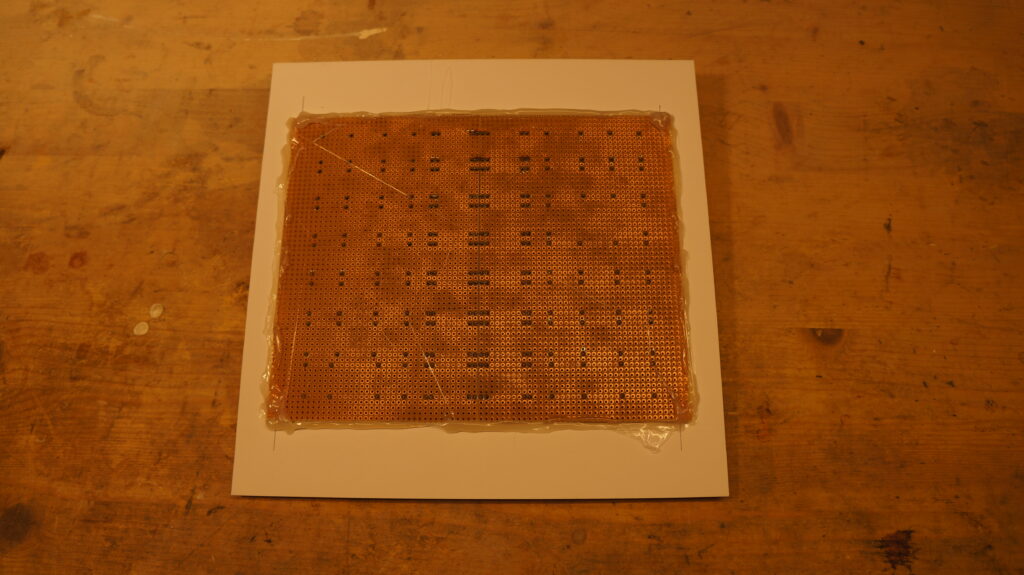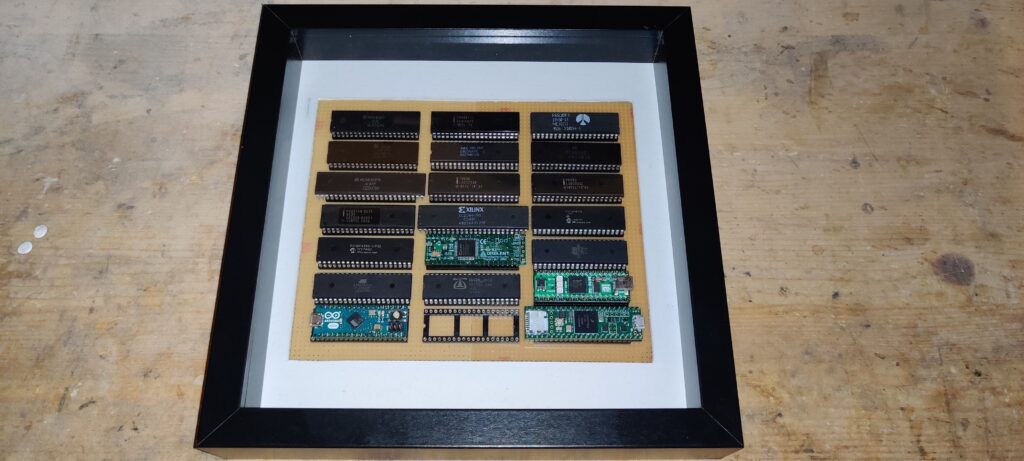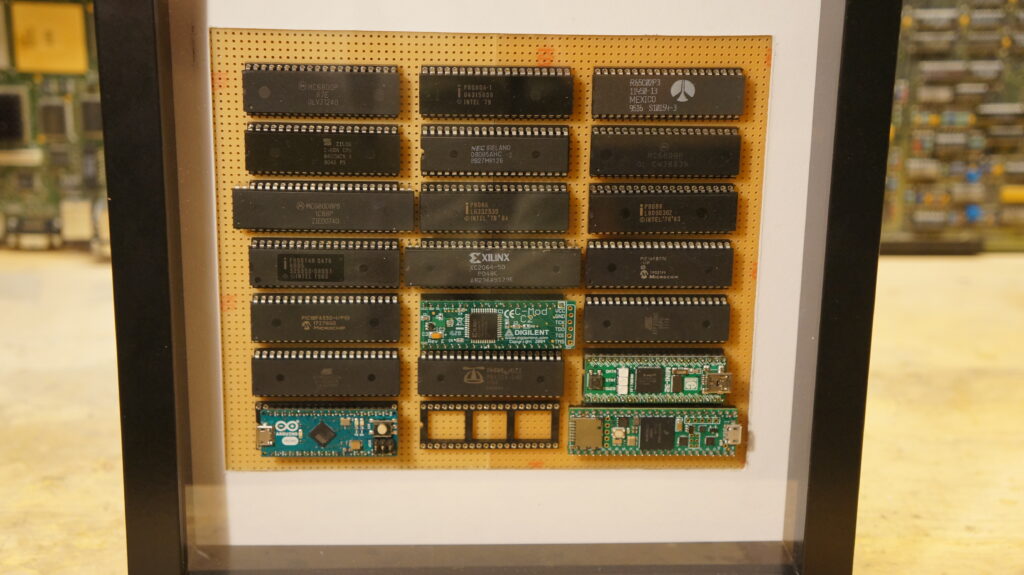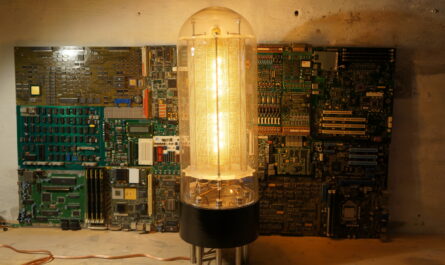Background
The first microcontroller I learned to program and got to understand the architecture of was the Atmel ATmega16/32 in a DIP40 package programmed with a STK500 board that can also be found on The Circuit Board Coffee Table. This chip fascinated me with all it’s build in peripherals inside a single chip. Other chips that I later played around with were the Microchip 16F877 and 18F4550 with USB interface. When I got interested in retro computing I came to know about 6809, 6502, Z80 and 8088/86, which all shared the common DIP40 package. I found myself collecting these devices without really knowing why and not knowing how to display them. I just knew I didn’t want to start a huge CPU collection, so I limited myself to the DIP40 form factor. Then at a natural museum’s shop I saw this little showcase with butterflies, wondering how cool it would look like with old DIP40 ICs in it instead of animals. I found the perfect frame for the showcase with an IKEA HOVSTA frame that had the right depth.
The ICs would be mounted in precision machined IC sockets soldered onto prototyping PCBs so it would be possible to swap them around if some was added or removed from the collection.
Scope of the collection
The overall theme of the DIP40 Frame of Fame is famous DIP40 microcontrollers and microprocessors with a few exceptions by type and package. Since the DIP40 package is now almost obsolete with new microcontrollers, breadboard friendly microcontrollers, mounted on a DIP40 size breakout board, are also included in the collection. This is my little version of a CPU collection with items I think has an importance to computer history. The name DIP40 Frame of Fame is somehow self explaining but is inspired from the Chip Hall of Fame.
Below is a list of the 21 ICs that can be seen in the DIP40 Frame of Fame sorted by release date and with a short description of specifications and a justification for relevance.
Specifications
| Date | Model | Bit | Speed MHz | Description | Uses |
| 1974, Marts | Motorola 6800 | 8 | 1-2 | Only required one supply voltage 5V | Computer peripherals, test equipment, POS terminals, SWTPC 6800, MITS Altair 680 |
| 1974 April | Intel 8080 | 8 | 2-3,125 | 2. 8-bit microprocessor by Intel (The 1. was 8008) | MITS Altair 8800, Processor Technology SOL-20 |
| 1975 | MOS 6502 | 8 | 1-3 | Derivative of the 6800 made by the former Motorola team, simpler and faster | Atari 2600, Apple I+II NES, Commodore 64+PET+VIC-20, BBC Micro, |
| 1976 | Zilog Z80 | 8 | 2,5-10 | Zilog’s first product, S/W compatible with 8080, popular with CP/M | Osbourne 1, Kaypro, Micro-Professor TODO LINK TO MPF-I, Epson PX-8+PX-4, Cambridge Z88, Amstrad NC100, TI-84 calculator |
| 1976 | Intel 8085 | 8 | 3-6 | Required less support circuitry than 8080 but still s/w compatible, build serial and interrupts, single supply 5V | TRS-80 Model 100 and similar, SAIA PCA1 PLC, Sojourner Mars Rover |
| 1978 | Motorola 6809 | 8 | 1-2 | Uses two 8-bit acc to combine into some 16-bit operations | TRS-80 Color, embedded controller |
| 1979 | Motorola 68008 | 8/32 | 8-16,67 | Version of the Motorola 68000 with a 8 bit ext. databus instead of 16 | Embedded systems, no computers |
| 1979 | Intel 8086 | 16 | 5-10 | First x86 architecture. Floating-point can by added by the 8087 mathematical coprocessor. | Compaq Deskpro |
| 1979 | Intel 8088 | 8 | 5-16 | The CPU in the original IBM PC. Modified version of 8086 with an 8 bit ext. databus allowing 8 bit memory. | IBM PC |
| 1980 | Intel 8051 | 8 | 12 | Single chip microcontroller, CISC, | Embedded systems |
| 1985 | Xilinx XC2064-50 | – | – | Xilinx’s first product | Development |
| 2001 | Microchip PIC16F877A | 8 | 20 | Popular PIC16 series among programmers | Embedded systems |
| 2004 | Microchip PIC18F4550 | 8 | 48 | Build in USB interface | Embedded systems |
| 2005 | Xilinx CoolRunner-II CPLD XC2C64 | CPLD, 64 Macrocells, JTAG programmable | Development | ||
| 2005 | Atmel ATF2500C | CPLD, 24 Macrocells | |||
| Atmel ATmega16/32 | 8 | 16 | The first MCU I learned to program | ||
| 2006 | Parallax Propeller P8x32A | 8×32 | Multi core processor with 8 32-bit RISC CPU cores | Development | |
| 2009 | MikroE Mini-32 PIC32MX534F064H | 32 | 80 | Pin compatible with 16F877 | Development |
| 2012 | Arduino Micro | 8 | 16 | Based on the ATmega32U4 microcontroller | Development |
| 2012 | Trenz TE0722 DIPFORTy (Need to buy it from Digikey) | 32 | Xilinx Zynq-7 SoC contains a FPGA an dual core ARM A9+ processor | Development | |
| 2020 | PJRC Teensy 4.1 | 32 | 600 | ARM Cortex-M7 RISC, fastest microcontroller available in 2020, Ethernet, USB, Micro SD | Development |
Disclaimer: The above information and years are based on Wikipedia articles and datasheets and are my best guesses. If you have any corrections you are welcome to contact me.










